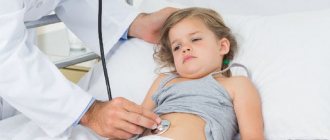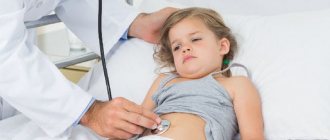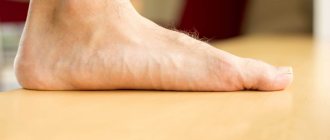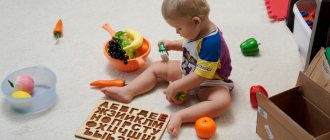Average reading time: 9 minutes
Publication date: August 09, 2021
Zakharova Carolina Yurievna
Physician and author of scientific articles on therapy, ophthalmology, pediatrics and psychiatry
One of the most common causes of diarrhea in children is rotavirus infection2,4. Rotavirus received its name due to its external resemblance to a wheel (rim with spokes), which in Latin sounds like “rota”1,4.
As a rule, rotavirus infection occurs in the form of acute gastroenteritis1,3 - inflammation of the mucous membrane of the stomach and small intestine. The disease is accompanied by vomiting and diarrhea1. In 60–70% of cases, these symptoms occur with fever, general malaise, body aches, runny nose, and throat discomfort—flu-like symptoms1,4. Because of this, rotavirus infection is often called stomach or intestinal flu3.
Up to contents
How can a child become infected?
There are certain conditions under which a child may get this infection. The occurrence of the disease will be facilitated by:
- Irregular and inadequate nutrition of the child;
- Poor hygienic and sanitary conditions in which the child and his family live;
- The child eating low-quality or stale foods;
- Presence of stomach and intestinal diseases;
- The presence of immunodeficiency conditions (the child often suffers from colds or is often treated with antibiotics)
The source of infection for rotavirus disease is a person who already has this disease. It is dangerous to others from the appearance of the first symptoms until the end of the disease (5-7 days).
This infection is transmitted through the digestive system. A child can become infected while swimming in a pond where there is rotavirus in the water. Infection can occur through dirty hands, dishes, towels, napkins, toys and other items if they were used by a sick person. The disease can also occur in a baby when consuming foods that contain rotavirus - most often these are various dairy products.
Rotavirus infection most often occurs in autumn or spring. A person can get this disease several times during his life.
From the moment of infection to the appearance of vomiting, abdominal pain or diarrhea in the child, it takes from several hours to several days.
Symptoms
Often, cases of the disease remain unidentified because they are perceived as ordinary intestinal disorders, go away on their own or with a diet, and do not entail visiting a doctor with mandatory testing to identify the pathogen. However, in some cases, this disease can lead to severe complications in children due to large fluid losses.
At the onset of the disease, the child may develop:
- Nasal congestion;
- Runny nose;
- Cough;
- Enlarged submandibular or other groups of lymph nodes.
When the disease develops:
- Stomach ache. Since the virus affects the intestines almost along its entire length, pain can occur throughout the abdomen or in different parts of it.
- Flatulence. Since at this time the intestinal cells release a lot of fluid into the lumen, gurgling and rumbling appears in the stomach. The affected intestines cannot properly and promptly digest and absorb food.
- The baby begins to vomit. It can be 1-2 times or more often. Vomiting continues for one to two days;
- Frequent loose stools, which may be yellow water. This symptom appears simultaneously with vomiting, or a little later. Loose, frequent stools in a child can last from several days to a week. During one day, stool can be several times, and in severe cases - more than fifteen times. This is caused by the affected intestinal cells releasing a lot of water.
- Body temperature rises. This symptom may last for one or several days in a child. These days there is lethargy, decreased appetite and mood.
- Pale skin;
- Lethargy;
- In an infant, you can find retraction of the large fontanel and eyeballs. All this will be a consequence of dehydration in the child;
- With severe rotavirus infection, the child may have seizures.
Recovery from rotavirus
Children exposed to rotavirus infection need special care and nutrition. The intestine damaged by viruses cannot fully perform its functions1. Therefore, nutrition should be gentle8:
- ● infants continue to be fed breast milk2,8 at least 6 times a day, initially reducing the amount of food (feeding time) by 30–50%2,8.
- ● bottle-fed children are first transferred to low- and lactose-free breast milk substitutes1,8, then, when the condition improves, lactose-containing products are introduced into the diet2,8.
- ● older children receive their usual drinks and foods2, with the exception of those that enhance fermentation, stimulate the motor activity of the gastrointestinal tract and the secretion of digestive juices8.
Up to contents
Diagnostics
In order for a doctor to diagnose rotavirus infection, it is necessary to conduct a stool test for the presence of particles of the virus genome in it (this method is called “polymerase chain reaction”). In addition, various other tests are performed on blood, urine and stool. This allows you to detect infection earlier and prevent complications in the child.
Under domestic conditions, it is very difficult to diagnose this infection for an ill family member. Therefore, consultation with a doctor is necessary in any case, no matter how confident a person is in this diagnosis and methods of its treatment. There are a large number of infectious and non-infectious diseases that occur with symptoms similar to rotavirus infection.
For example, parents may mistake non-infectious diseases of the liver, stomach, intestines, and pancreas for a manifestation of rotavirus infection. With them, the sick child complains of nausea, vomiting, abdominal pain after certain (fatty, spicy, fried) foods, or indicates that all manifestations are disturbing only on one side of the body and began after severe emotional stress.
Similar signs of the disease can occur in case of poisoning with drugs or poisonous plants (more often it is children who suffer from this if they are left alone at home and can get to the home first aid kit, or walk unattended and can try different berries).
Read more about food poisoning in children in our article “Recommendations from a pediatrician for food poisoning in a child.”
Online consultation with pediatrician Olga Nikolaevna Tekutyeva
Registration online
During the consultation, you will be able to voice your problem, the doctor will clarify the situation, interpret the tests, answer your questions and give the necessary recommendations.
Treatment
Rotavirus infection occurs differently in different children - in mild, moderate and severe form. If vomiting and loose stools in a child are not very frequent, then they speak of a mild form of rotavirus infection. The more often a baby has vomiting and diarrhea, the more fluid and microelements his body will lose, and the more severe this disease will be. Loss of water through stool and vomiting in a child leads to dehydration. If, with frequent vomiting and loose stools, you do not try to give a sick child a little water, this can lead to serious consequences of dehydration.
Treatment for rotavirus infection should begin as early as possible. Unfortunately, there is currently no drug that would directly destroy rotavirus. The main treatment is to restore the loss of fluid that leaves the body through vomiting and stool. The child is given oral rehydration - fed in small doses. It is best to restore fluid loss with solutions that contain sodium, potassium and glucose salts.
Grodno Regional Children's Clinical Hospital
Details Published September 22, 2021
Rotavirus infection in children
According to WHO, every person (regardless of immunity status, gender and race) has had rotavirus infection. And those who have just been born will still have to get sick from rotavirus.
What is rotavirus infection, why is it dangerous and how to identify it? We will try to answer these and other questions in our article.
So, rotavirus infection is one of the acute intestinal infections caused by pathogens from the rotavirus family. Sometimes people call this disease “intestinal flu,” which is fundamentally wrong, since influenza viruses can exist and multiply only on the mucous membranes of the respiratory tract. But rotavirus “lives” in the small intestine and has nothing to do with damage to the respiratory tract.
Most often, this infection occurs in childhood and during the cold season. The virus is transmitted by contact - fecal-oral. You can become infected from a sick person through toys, dishes, door handles, household items, through water and food. The virus is very contagious!!!
After illness, a strong immunity to rotavirus is developed, but, unfortunately, it has almost no significance, since this virus has many varieties. Those. a person can become infected again.
After infection, the virus “lives” and multiplies in the human body asymptomatically for 3-7 days (incubation period). The disease itself takes about 2-3 days, sometimes up to 7—the acute period. The recovery period continues for at least another 5 days after the symptoms disappear.
A child is contagious ALL THE TIME from the moment of infection until the end of the recovery period!!!
The likelihood of infection does not depend in any way on the cleanliness of the child’s family. Children aged 6 months to 2 years are most often affected. In general, children from birth to 5 years of age are at risk.
The main symptoms of rotavirus infection are:
– watery diarrhea (diarrhea) without signs of blood;
- vomit;
– a sharp increase in temperature to high numbers (39 and above);
– pain in the abdomen;
- lack of appetite;
- loss of strength, weakness.
Diarrhea is the main symptom of rotavirus infection. As a rule, it lasts no more than 2 days, but is dangerous due to dehydration.
Dehydration is always a risk of damage to the nervous system, especially in children under 2 years of age. Body temperature may rise sharply, causing convulsions and then respiratory arrest. In addition, a lack of fluid in the body impairs the functioning of the lungs, which can lead to inflammation.
A typical picture: a child with dehydration ends up in the hospital, and 2 days later pneumonia is also discovered. His parents think that he became infected in the hospital, but in fact, lung problems are a common complication of any intestinal infection.
How can parents determine whether diarrhea is caused by a viral infection or food poisoning?
Food poisoning is caused by bacteria and diarrhea most often has a pasty consistency. Diarrhea with water, sour smell of feces - viral diarrhea.
The main thing that parents must learn to do is to quickly assess whether the child has signs of dehydration, since it is dehydration that poses a danger to life and health.
In all cases of diarrhea and/or vomiting in a small child, you should consult a doctor!
What symptoms should parents be alert to regarding dehydration?
If a baby's tongue becomes dry, he begins to cry without tears, does not urinate for more than 6 hours and practically does not sweat - this is a good reason to call an ambulance.
If the baby begins to lose consciousness, the eyes are “sunken,” the facial features are “sharpened,” and the body temperature is high—the help of doctors is required immediately.
If a child begins to become dehydrated and cannot or does not want to drink, then it is necessary to introduce fluid into the body intravenously. This is what inpatient treatment is based on.
If there are no signs of dehydration, then parents can easily cope with rotavirus infection at home.
So, what do you need and can do yourself?
The main principle of treating rotavirus infection is to prevent dehydration. To do this, the child must drink and drink a lot. The more often the better. You can drink in small portions, if it is difficult to drink in sips, from a teaspoon, from a syringe without a needle, but often.
The drink should be at room temperature, neither cold nor hot.
For drinking, it is better to use a saline solution, which is sold in a pharmacy, for example “Regidron” or similar ones. You can alternate the saline solution with regular boiled water. If your child urinates every 3 hours, it means he is consuming enough fluid.
If you can’t get something to drink even from a syringe or the child doesn’t drink enough, be sure to call an ambulance!
If, in addition to diarrhea, the child has vomiting, then the baby should be placed on his side so that he does not choke on the vomit.
Give antipyretics at a temperature of 38.5 and above (if there are no other indications).
Do not feed, especially by force! If your child asks to eat, you can give him some liquid porridge with WATER!
The diet should be followed not only during the acute phase of the disease, but also during the recovery process. Whole milk and dairy products, sweet fruits, baked goods, sweets, meat, fatty and fried foods are completely excluded from the diet. YOU CAN: water porridge, vegetable soups, white bread croutons, oven-baked apples. Feed frequently, but in small portions.
Very young children are not given a diet, breast milk is not limited, but they make sure that they drink plenty of fluids. Sometimes, due to an enzyme deficiency, infants may develop intolerance or partial intolerance to breast milk. In this case, reduce the frequency of breastfeeding and temporarily add lactose-free infant formula (until the child recovers completely).
You cannot take antibiotics on your own, since the disease is viral in nature, and antibiotics do not work on viruses.
As for antiviral drugs, unfortunately, at the moment there are no antiviral drugs with proven effectiveness against rotavirus.
Do not take antidiarrheal drugs! During rotavirus infection, microparticles of the virus are released in the stool. Therefore, stopping diarrhea means prolonging the disease, since virus particles will remain in the small intestine and continue to destroy beneficial cells.
Bed rest is not necessary if the child feels well enough. After the symptoms disappear, you can go for a walk, but avoid public places and contact with other children (playgrounds, playrooms, etc.).
A child can be sent to a kindergarten or school only after a recovery period, i.e. 5-7 days after the cessation of diarrhea and vomiting.
Doctor - pediatric neurologist KFD Glybokaya O.L.
What can parents do before the doctor arrives?
Even before the doctor arrives, parents should start giving their sick child something to drink. You can try to do this in various ways. Some children drink well during illness using a spoon. Someone will have to slowly pour liquid into their mouth from a syringe. The main thing is not to rush and do it evenly and regularly - 5-20 ml every few minutes. If the baby continues to have nausea or vomiting, you need to make the intervals between drinks a little longer, but do not stop offering the patient something to drink. In addition to saline solutions, it is useful to drink dried fruit compote and chamomile decoction.
To reduce the symptoms of the disease, sorbents and preparations containing probiotics are used. Sorbents ensure binding and removal of the pathogen from the body. For this purpose, carbon, fibrous, mineral or synthetic sorbents can be used, which effectively sorb and remove from the body food decomposition products formed during enzymatic deficiency, help accelerate epithelial regeneration, reduce flatulence and pain, and also do not affect the composition of normal intestinal flora .
In some situations, enzymes may be used in treatment if the child has difficulty digesting food due to severe damage to the intestines and pancreas.
In addition to medications, it is important to pay attention to diet during illness. To prevent nausea, food should be given to the child in small quantities and more often. For about a month, you should exclude dairy products, fresh vegetables, fruits, pasta, baked goods, pastries, sweets, and fried foods from your diet.
Food is served to the patient boiled, stewed or baked without crust. The child should have such food for about a month, and then the diet can be gradually expanded.
If you rush and do not follow a diet, recovery will slow down. Complications may arise and chronic diseases of the liver, stomach, intestines or pancreas may develop.
Prevention of rotavirus infection
In order to prevent the occurrence of the disease, it is necessary to follow simple and familiar everyday rules - wash your hands before eating, when returning home from a walk, after communicating with a sick person. These same rules must be taught to every child from a very young age. If someone in the family is sick with rotavirus infection or another infectious disease, then the patient should have separate dishes, towels, bed linen and household items, which should be soaked daily in disinfectant solutions and thoroughly washed with hot water or boiled.
The most effective way to prevent any infectious disease, including rotavirus infection, is vaccination, which can be given to children aged 1.5 to 8 months. Vaccination takes place in three stages with an interval of at least four weeks between each vaccination. It involves dropping vaccine drops into the baby's mouth. The main thing is that the child is healthy at this moment. Then, after proper vaccination, your baby will be protected from a very unpleasant rotavirus infection.
Even after suffering a rotavirus infection, there is a chance to get this disease again, since the body does not always develop lasting immunity to the disease. Therefore, it is important for parents to always follow hygiene rules and not forget to vaccinate their child.
Immunomodulatory and antiviral therapy
When confronted with rotavirus, the maximum level of immune defense does not develop immediately. In order for post-infectious immunity to be formed, 3 consecutive “meetings” with rotavirus are needed, and there should not be long intervals between episodes of the disease1. The fact is that rotaviruses are a heterogeneous group4, and there are different strains (subspecies) of the pathogen, which can cause repeated infections1.
Immunity plays a special role in protecting against subsequent infections with rotavirus1. Therefore, additional preventive measures should be taken in children with weakened immune systems1,5.
Anaferon® for children has antiviral and immunostimulating activity7,11. Due to the content of antibodies to human interferon gamma, the drug reduces the concentration of viruses in affected tissues, activates immune cells, and accelerates the production of antibodies7,11.
The following can be used as part of complex therapy for rotavirus infection:
- ● Anaferon® for children in the form of lozenges - for children from 6 months to 18 years7.
- ● Anaferon® children's drops for oral administration - intended for children from 1 month to 3 years11.
Anaferon® for children is one of the most studied antiviral drugs in Russia12. It has a favorable safety profile13, promotes speedy recovery and prevention12 of complications, and thanks to this has gained well-deserved recognition from specialists12.
Up to contents










